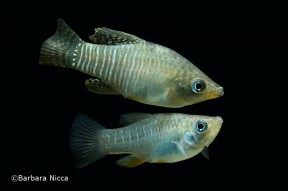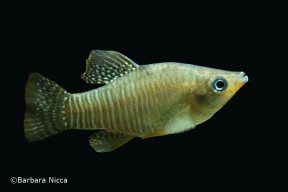Adinia xenica
Diamond Killifish
Classification
Order: Cyprinodontiformes Family: Fundulidae
Distribution
The type series was collected from around the coastal islands of Galveston and San José as well as the former port of Indianola, all located in Texas, United States of America. The latter is now an official ghost town having been destroyed by hurricanes on two separate occasions in the late 19th century. It’s natural range is now known to encompass the entire northern Gulf of Mexico, from the southern tip of Florida to Texas.
Habitat
Inhabits shallow (usually less than 30 cm deep) coastal waters including lagoons, salt marshes, isolated pools and first order streams, typically in areas where submerged vegetation and/or filamentous algae grow thickly. It’s normally found in brackish waters and also thrives in hypersaline conditions but fares less well in fresh water to which prolonged exposure apparently causes depletion of blood salts.
Maximum Standard Length
40 – 50 mm.
Aquarium SizeTop ↑
A pair or small group can be maintained in a tank with base dimensions of 60cm x 30cm but we recommend keeping a larger group in accordingly-sized quarters.
Maintenance
Even for long-term maintenance a simple set-up will suffice. The most important factors are the provision of many broken lines of sight and a suitable medium in which the fish can deposit eggs. Female and subdominant male individuals must be offered the opportunity of respite from the aggressive alpha males during the spawning season so much of the available space can be filled with acrylic wool mops (use a fine grade if available), clumps of java moss or Ceratophyllum and ideally filamentous algae. There is no need to add a substrate although inert sand or gravel can be added if you prefer, and filtration need not be too strong either. The addition of marine salt at a rate of 3-10 g/L should be considered essential, however.
Water Conditions
Temperature: 21 – 35 °C. Somewhere around the middle of this range should prove best for general maintenance.
pH: 7.5 – 9.0
Hardness: 179 – 536 ppm
Diet
A generalised omnivore feeding on small organisms from submerged vegetation or the water surface. These may include blue-green and filamentous algae, diatoms, pollen granules, vascular plant matter, rotifers, nematodes, copepods, ostracods and dipteran larvae. In the aquarium dried foods are normally accepted but should be supplemented with regular meals of small live or frozen fare such as Artemia, Daphnia or chironomid larvae (bloodworm). If the aquarium or container does not contain live algae a quality dried product with added Spirulina or similar may prove useful. Hastings and Yerger (1971) reported that juveniles are notably more carnivorous than adults.
Behaviour and CompatibilityTop ↑
Not a good choice for the community aquarium given its water chemistry requirements and rarity in the hobby, and we strongly recommend maintaining it alone. It should be kept in a group with a ratio of two or three females to each male being the ideal.
Sexual Dimorphism
Adult males tend to be larger and more colourful than females with sexually mature individuals developing longer unpaired fins, plus bony projections normally referred to as ‘contact organs’ on the body above and behind the anal fin and on the fin itself.
Reproduction
Captive reproduction is not normally difficult if the tank or container is properly arranged and maintained (see ‘tank set-up’). It is a fractional spawner with females depositing eggs on a more-or-less continuous basis between the months of March and September, typically during the afternoon. These are laid singly and a female individual may produce up to 30 or so daily. the adults typically eat their eggs/fry and the medium should therefore be checked on a daily basis during the spawning period or the adults removed post-spawning.
If you wish to remove eggs use a fine pair of forceps to gently remove pieces of medium with eggs attached whilst avoiding contact with the eggs themselves. Alternatively the entire medium can be removed and replaced every couple of days. The medium/eggs should be transferred to a container with water of the same chemistry and temperature as that of the adults. The incubation period can vary a little with the temperature but is usually between 9-11 days with the fry being large enough to accept Artemia nauplii, microworm etc. immediately after they become free-swimming.
NotesTop ↑
This species is not a common aquarium species but is occasionally available from specialist retailers or breeders. It was initially named Adinia multifasciata by Girard (1859) before later being redescribed as Fundulus xenicus (mispelled ‘Fundnlus‘) by Jordan and Gilbert (1882).
Body stout and trapezoidal in adults, body depth usually 2 to 3 times in standard length; scales large, fewer than 30 scales along midlateral scale row






August 1st, 2012 at 7:29 pm
Hello, I’m trying to contact Barbara Nicca about using her photos:
I’m an exhibit designer in Boston, MA. I found your site while looking for photos for fish ID panels at the the Apalachicola National Estuarine Research Reserve. I’m so glad I came across your Diamond Killifish photos! We would like to use the single male adult photo in the exhibit and are willing to pay for reproduction rights.
Let me know if you’re open to participating in our project. You can find out more about Apalachicola NERR, a nonprofit nature center in Florida, here: http://nerrs.noaa.gov/Reserve.aspx?ResID=APA
Thanks, and I look forward to hearing from you.
August 2nd, 2012 at 8:15 am
Hi there, I’ll ask Barbara and get back to you. Your project looks very interesting.